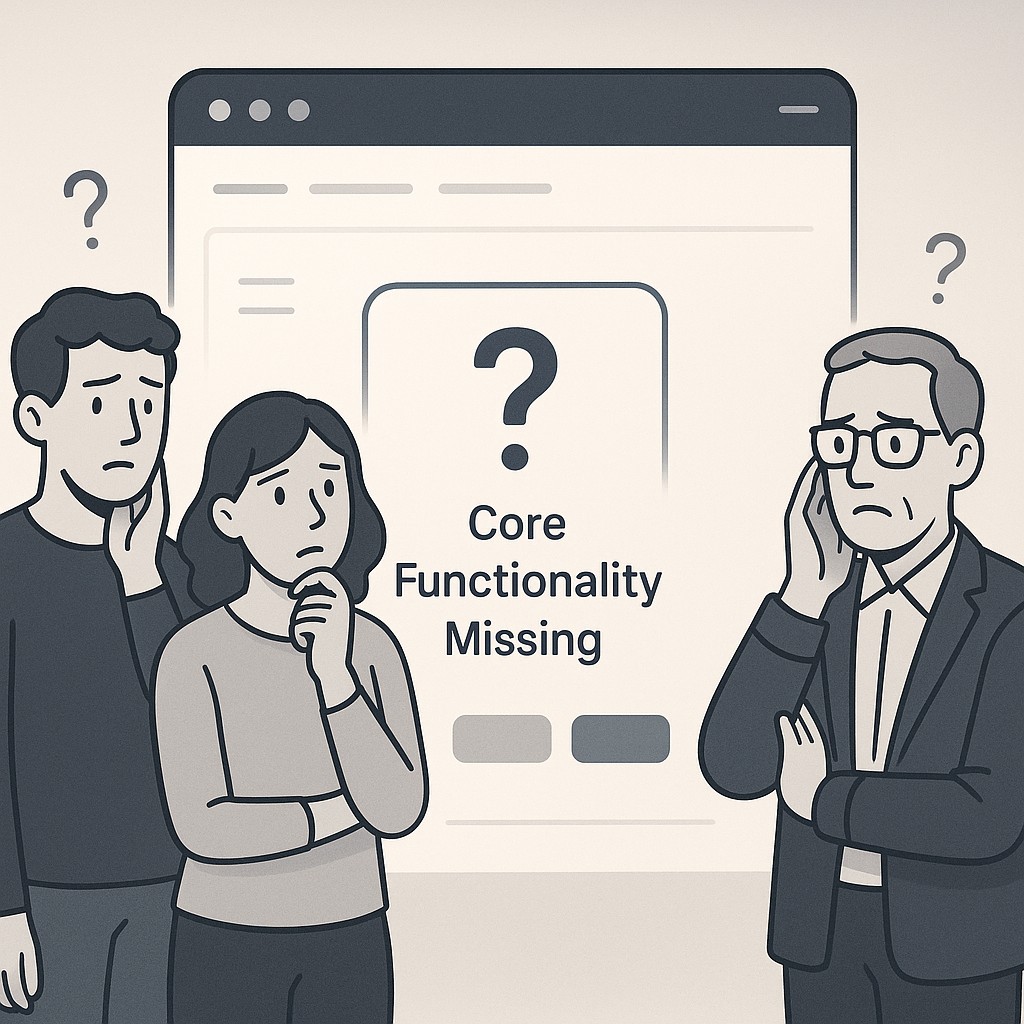Stop Productivity Theater by Anchoring Sprints to One Outcome
Stop Productivity Theater by Anchoring Sprints to One Outcome

Stop Productivity Theater: When Polish Covers the Problem
Early in my career, I was the person polishing demos late into the night, not yet willing to stop productivity theater and focus on real progress. I’d zoom in on every corner pixel. If a slide transition snagged for half a second, I’d redo it. I honestly believed every tiny touch mattered, that attention to detail was how you showed respect for the work. To me, polish was proof I cared about users, proof I was taking launch week seriously. I’d convince myself the team needed a flawless first impression, even if it meant endless rounds tweaking button colors or reworking animations that only I seemed to notice. I was sure this was what delivered a great product.

But when we finally showed it to stakeholders, they didn’t care about the shine. All that polish? It didn’t matter. What they saw was a giant hole. Core functionality missing.
That was the gut punch. We’d spent weeks “showing progress”—beautiful surfaces, everything in place for a slick walkthrough. But while we were busy making things look launch-ready, the essential work was lagging in the background. Motion isn’t progress. You can sprint through task lists and feel productive, but if the core value isn’t there, none of it sticks.
It’s a trap I see everywhere. Productivity theater feels satisfying, so learn to avoid it because it fails users when outcomes aren’t met. Effort feels good, but impact is what actually counts.
So I’ll challenge you, because I wish someone had done it for me. Are you moving forward—or just moving? If you want to actually close gaps and build trust, anchor your next sprint to a single outcome that changes the game. That’s when you spot what’s essential, stop the busywork, and ship something rough but real. Changing this habit shifted everything for me. I wish I could say I never slipped back—sometimes old habits tug at you, especially when you want to impress—but catching myself is easier now.
Why Motion Feels Like Progress (But Isn’t)
Productivity theater sneaks in when our teams work hard but get nowhere, usually because the goalposts aren’t clear and we fail to choose outcomes over outputs. It looks good. Lots of updates, demos, revamped dashboards. But under the surface, not much is actually changing for your users.
Quick check: if you finish a task and the actual experience or key metric doesn’t budge, that’s theater, not progress.
Think of it like this. Motion is effort with no direction, just magnitude, like a scalar. Progress has both size and direction, like a vector. It actually gets you closer to a real outcome. You can fill days with activity, but unless work is aimed at a concrete result, you’re stuck spinning your wheels, even if everyone looks busy.
I’ve done it. Lost whole afternoons perfecting UI animations, retuning a model so performance curves looked “smoother,” or even just reorganizing my to-do list for the fifth time. None of that moved the core outcome forward. It was easy to convince myself I was building, but nothing changed where it mattered.
The Core Method: Outcome, Slice, Ship
In outcome-focused development, here’s the question you need to stare at before your next sprint: What outcome am I aiming for? That’s it. Not “How many tickets can I close?” or “How smooth can the UI feel?” but a one-sentence goal for this sprint that’s focused, measurable, and time-bound. It gives you an actual north star for every decision. Center this goal, and suddenly the avalanche of tasks starts to look a lot simpler.
A good outcome is clear. Pick one user-visible metric, lock it to a deadline, and make sure you can test it with a small slice of work. That metric should move the needle for your release, not just make the backlog smaller. Product outcomes change what customers do, while business outcomes track company health—which means your sprint should anchor to a metric that drives customer behavior; see Product Talk.
There was one Monday morning, maybe four months ago, when I spent more time choosing between two shades of gray for a dashboard card than I did mapping out what would actually help users finish their workflow. I’m not proud of that. Most of the team had no idea what I was doing, and by lunch I’d barely touched the stuff that mattered. It’s like chasing the perfect cup of coffee, focusing on how it looks but ending up with flavor that doesn’t really land.
So here’s what works. Align work to outcomes by mapping every task against your outcome. If a task doesn’t measurably move that metric in this sprint, cut it. Ship the smallest possible slice that actually nudges the result—even if it’s ugly, incomplete, or a little embarrassing. Value comes first, polish comes way later. This approach forces you to get honest about which work pushes the needle and which is just busywork. Letting go of the rest gives you room to iterate quickly and start real conversations about what actually matters. Deliver value—flaws and all.
Take a new ML feature. Instead of spreading effort across everything, ship user value by picking one metric—say, top-3 accuracy on your most critical segment. Ship a basic model that bumps that number, even if the UI is half-baked and the edge cases aren’t handled. The rough version still delivers core progress.
True progress happens when you focus on solving meaningful problems—not just looking busy. Motion feels good, but impact is all that counts. Anchor your work to real outcomes, and the tradeoffs get much easier.
Turning Goals Into Sprints That Actually Move the Needle
If I could give you one repeatable plan, it would start here. Pick a single, high-impact outcome for your sprint. Write it down. Now make a list of every task you think you’ll need to do. Go down that list and mark each task honestly—does it actually move that outcome, or is it just there to make things look good? Then pick the smallest functional slice that actually creates change for users, even if it’s a little messy, and commit to shipping that this week. I won’t lie. It feels uncomfortable at first, like skipping the “normal work.” But this method finally cut down my cycle of perfecting tiny details that didn’t change anything.
Here’s how I gut-check each task. If I remove it and the core outcome metric or user experience stays the same, it’s gone. If pushing out an ugly prototype bumps the metric or unblocks a user path, it ships. Lean engineering is brutal about this. It boils down to cutting waste, delivering fast, and focusing only on what moves the needle. Anything else is just noise.
Once you’ve trimmed ruthlessly, it’s time to communicate what’s included—and what’s out. When you share your cut list, clear trade-offs, and the outcome you’re targeting, stakeholders see the real movement. You reframe progress as delivering impact, not chasing perfect polish. Invite them into your thinking. Here’s what we’re shipping, here’s what we cut, and this is how it moves the outcome. Suddenly feedback is about results, not missing bells and whistles.
Of course, shipping something imperfect means risk. Be direct. Document the flaws you know about, set up simple guardrails, and make a realistic plan for refactoring afterwards. Trust comes from showing you’ll fix what’s left behind, not pretending it’s perfect. Honestly, I’ve earned more trust confessing rough edges up front than I ever did delivering pixel-perfect, low-impact launches.
Ship Imperfect—Build Trust on What Matters
It’s natural to worry that shipping something imperfect will haunt you later. I get it. A half-finished UI or scrappy release can look like you’re cutting corners, and that fear of “debt” is real. But if you anchor your sprint to a clear outcome, you actually can point to real change for users. That’s what gives you confidence to ship before everything is shiny. Instead of stressing over polish, you’re able to say: “Here’s what actually moved, here’s what can wait.” When you center the conversation on outcome—not optics—you build credibility through results, not appearances.
This week, use a script: “Our goal is [X outcome]. The smallest slice that moves this is [Y]. We’re shipping that now, and holding [Z] for later. What should we tackle next?” Naming what you’re moving, what you’re skipping, and inviting feedback shifts the focus away from theater and toward impact.
If you need fast, high-quality drafts for updates, specs, and stakeholder notes, try our app to generate AI-powered content you can edit and ship quickly.
So pick one outcome, stop productivity theater, and move the needle. Circle back once the real gap is closed—then refine what’s left. That’s how you build trust that lasts.
I’d be lying if I said I don’t still hesitate sometimes when releasing something that feels obviously unfinished. I keep thinking, what if someone calls me out for skipping steps? Right now, I haven’t let go of all those old instincts—they pop up whenever the launch gets close. Maybe there’s a balance I haven’t found yet. But at least now, I know what actually matters is moving the core metric, not perfecting the surface.
Enjoyed this post? For more insights on engineering leadership, mindful productivity, and navigating the modern workday, follow me on LinkedIn to stay inspired and join the conversation.
You can also view and comment on the original post here .
